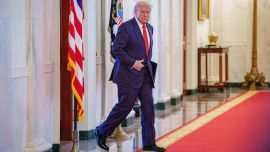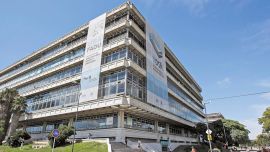Mexicans may be descended from the Indians and Brazilians might be offshoots of the jungle while Argentines came off the boat, but today’s column will sidestep all three in favour of Peru on the primitively simple grounds that they voted for a new president last weekend (if indeed they did). In fact, Peru was unjustly omitted from the presidential gaffe of the week misquoting the wrong author – Carlos Fuentes (not Octavio Paz) actually said: “We Mexicans descend from the Aztecs, the Peruvians descended from the Incas while the Argentines descended from their boats,” whereby he was denigrating the latter as parvenus nouveaux riches, recent arrivals on the continent without the venerable roots of an ancient indigenous civilisation.
But let us now leave Litto Nebbia’s guitar to gently weep and concentrate on today’s subject – Peru’s photo finish in the run-off between the apparent president-elect, the eccentric socialist Pedro Castillo (50.2 percent), and Keiko Fujimori (49.8 percent), heiress of an authoritarian dynasty. Peru overlaps with Argentina in past, present and (potentially) future tenses so let us proceed in that order.
Peru first came to my attention at an early stage in my Buenos Aires Herald newsroom experience – in 1986 when its youthful new President Alan García visited this city, inspiring the CGT then staging 13 general strikes against the Raúl Alfonsín presidency to paper downtown everywhere with posters reading: “My fatherland, give me a president like Alan García.” The Aprista populist was then at the peak of his honeymoon but the contrast with Alfonsín insistently claimed by the CGT reflected a time lag more than anything else, with García starting two years later, because the two presidencies had remarkably similar outcomes. García made a splendid start with his populist public spending surge triggering seven percent growth rates in his first two years, giving him initial popularity ratings of 96 percent, but his first presidency ended disastrously with economic shrinkage of 14 percent and 2,775 percent hyperinflation in 1989 – the same year as the hyper of 3,080 percent toppling Alfonsín here. As a sidebar, that 1986 visit here was with an Argentine first lady – Córdoba-born economist Pilar Nores.
García (1985-1990) was succeeded for the rest of the century by Alberto Fujimori, a virtual contemporary of the late Carlos Menem with other points in common. Both traced their ethnic origins to Asian nations (even if at opposite ends of the continent, Syria and Japan) and both made consigning hyperinflation to the past their launching-pad – “Fujishock” (kept hidden during the election campaign, just like Menem) was tough medicine at first but it had transformed the 1989 plunge of minus 14 percent into 13 percent growth by 1994. But while Menem always flaunted a caudillo image, Fujimori carried these authoritarian instincts one step further with the “self-coup” of 1992 obliterating the other two branches of government – the agronomist argued that parliamentary democracy was too much of a luxury for a government battling inflation and the Sendero Luminoso Maoist guerrillas (who had been virtually crushed by that stage). Increasingly oppressive with massive human rights violations marring his successful anti-guerrilla campaign, Fujimori was nevertheless re-elected in 1995 (the same year as Menem) by 64 percent of a grateful citizenry giving priority to stability with a brief border war with Ecuador just before the vote (which landed Menem with house arrest and a conviction on gun-running charges years later) spuriously fuelling patriotism.
Again like Menem, the second term was far less eventful and successful than the first and failed to pave the way for a third (in Fujimori’s case the fraudulent elections of 2000 were not allowed to stick). From this second term this columnist chiefly remembers the four-month hostage crisis in the Japanese Embassy (a personal shock as an annual guest at the Japanese Imperial Birthday reception here which the guerrillas had gate-crashed in Lima). Finally, the evil genius of the Fujimori regime was the sinister Vladimiro Montesinos (an Army captain in his pre-political career just like Brazilian President Jair Bolsonaro) until exposed by the Vladivideos – since the Marxist ideologue behind Castillo today is Vladimir Cerrón, why must the éminence grise in Peru always be Vlad the Bad?
To leave some space for the present and future, let us now fast-forward to recent years through Alejandro Toledo (2001-2006), the second term of Alan García (whose Odebrecht scandal tragically drove him to suicide just before his arrest two years ago) and Ollanta Humala (2011-2016) – three men with highly differing ideas and backgrounds but broadly similar policies fostering the Peruvian growth model and all ending their terms comfortably. But things have taken a turn for the worse ever since 2016 when banker Pedro Pablo Kuczynski (this columnist remembers his brother Michael from his Cambridge days as a brilliant and multilingual economics lecturer at Pembroke College) pipped Keiko Fujimori with a run-off vote of 50.1 percent (an even tinier margin than Castillo) – PPK, then already aged 78, was the first of four presidents since then.
Political gridlock (with the Fujimori solution impossible to repeat) and Odebrecht corruption were the main causes of a downturn accelerated by PPK’s ouster in 2018 but the coronavirus pandemic has turned the decline into a free fall – indeed the worst in the region after Venezuela. Argentina is doing badly enough with an economic slump of minus 9.9 percent last year and 83,000 of our 45 million dead in the last 15 months but the equivalent figures for Peru are minus 11.2 percent in 2020 and a death toll of 187,500 out of a population of 33 million. The higher they come, the harder they fall, one might say (the Peruvian success story had averaged almost five percent annual growth in the quarter-century preceding the pandemic) but perhaps the root cause of the disaster has been the informal basis of growth, making both employment and health coverage too precarious.
This instability is far from ending with Sunday’s vote. Castillo’s victory has yet to be confirmed while his leftism (his brand of socialism seems closest to Bolivia’s Evo Morales, annexing mineral wealth to the state, while co-existing with hostility to abortion and gay marriage) is likely to cause acute market turbulence. Impossible to forecast the future except to say that it might just be shared by Argentina, starting with totally unexpected successes for fringe candidates in the midterms (Castillo’s first-round vote was 19 percent while then Santa Cruz Governor Néstor Kirchner had single-digit popularity ratings at the start of 2003). If Alfonsín was a couple of years ahead of Alan García on the slippery slope in 1986, Peru could be a few steps ahead of us today.



















Comments